
Building a foundation: understanding and applying robust measures in data analysis
Originally appeared here:
Robust Statistics for Data Scientists Part 1: Resilient Measures of Central Tendency and…


Building a foundation: understanding and applying robust measures in data analysis
Originally appeared here:
Robust Statistics for Data Scientists Part 1: Resilient Measures of Central Tendency and…
With Streamlit’s sophisticated chat interface, a powerful GPT-4 backend and the OpenAI Assistants API, we can build pretty much any…
Originally appeared here:
Create a Specialist Chatbot with a Modern Toolset: Streamlit, GPT-4 and the Assistants API


Why should the number of independent row vectors precisely equal the number of independent column vectors for all matrices?
Originally appeared here:
A Bird’s-Eye View of Linear Algebra: Rank-Nullity and Why Row Rank Equals Column Rank


When getting started with data science, time series analysis is a common thing people would love to try themselves! The general idea here is to learn from historical patterns over time to predict the future. Typical use cases could be weather predictions or sales forecasting. But what does all this have to do with this wise prophet below?!

This article aims to take away the entry barriers to get started with time series analysis in a hands-on tutorial using one of the easiest tools called Facebook Prophet within Google Colab (both are free!). In case you want to get started immediately, feel free to skip the next two chapters where I will give a short background on time series principles and also Facebook Prophet itself. Have fun!
This article is structured into three main sections:
#1 Brief introduction to Time Series Analysis principles
#2 An Introduction to Facebook Prophet
#3 Hands-on tutorial on how to use Prophet in Google Colab (for free)
Imagine you are a store manager for consumer products and you want to predict the upcoming product demand to better manage the supply. A reasonable machine learning approach for this scenario is to run some time series analysis which involves understanding, modeling, and making predictions based on sequential data points. [1]
The below graphic illustrates an artificial development of historic product demand (dark-blue line) over time, which can be used to analyze a time series pattern. Our ultimate goal would be to predict (red-dotted line) the actual future demand (light-blue line) as precise as possible:
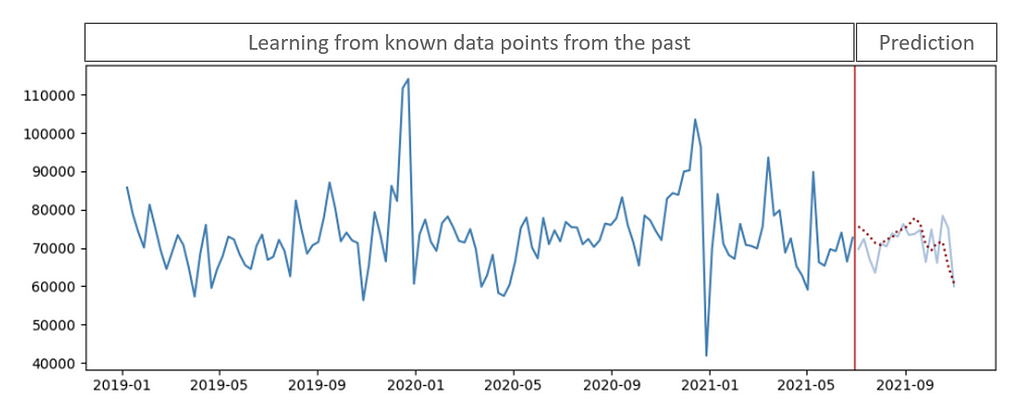
A time series is typically decomposed into three main components:
The decomposition of a time series into these three components, often referred to as additive or multiplicative decomposition, allows analysts to better understand the underlying structure and patterns. This understanding is essential for selecting appropriate forecasting models and making accurate predictions based on historical data. [2]
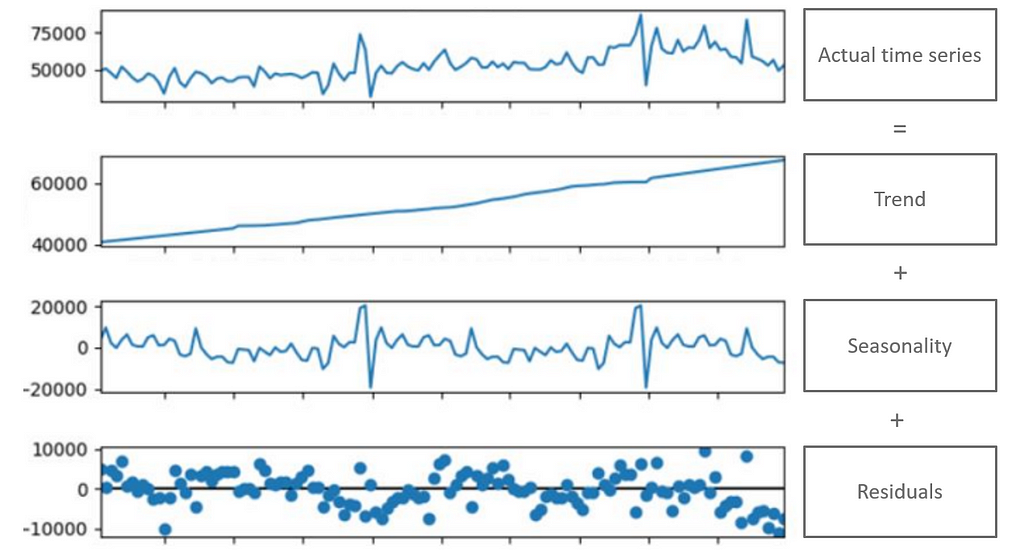
Prophet is an open-source tool released by Facebook’s Data Science team that produces time series forecasting data based on an additive model where a non-linear trend fits with seasonality and holiday effects. The design principles allow parameter adjustments without much knowledge of the underlying model which makes the method applicable to teams with less statistical knowledge. [3]
Prophet is particularly well-suited for business forecasting applications, and it has gained popularity due to its ease of use and effectiveness in handling a wide range of time series data. As with every tool, keep in mind that while Prophet is powerful, the choice of forecasting method depends on the specific characteristics of the data and the goals of the analysis. In general, it is not granted that Prophet performs better than other models. However, Prophet comes with some useful features e.g., a reflection of seasonality change pre- and post-COVID or treating lockdowns as one-off holidays.
For a more in-depth introduction by Meta (Facebook) itself, look at the video below on YouTube.
In the following tutorial, we will implement and use Prophet with Python. However, you are more than happy to run your analysis using R as well!
In case you have limited experience with or no access to your coding environment, I recommend making use of Google Colaboratory (“Colab”) which is somewhat like “a free Jupyter notebook environment that requires no setup and runs entirely in the cloud.” While this tutorial claims more about the simplicity and advantages of Colab, there are drawbacks as reduced computing power compared to proper cloud environments. However, I believe Colab might not be a bad service to take the first steps with Prophet.
To set up a basic environment for Time Series Analysis within Colab you can follow these two steps:
pip install prophet
from prophet import Prophet
I uploaded a small dummy dataset representing the monthly amount of passengers for a local bus company (2012–2023). You can find the data here on GitHub.
As the first step, we will load the data using pandas and create two separate datasets: a training subset with the years 2012 to 2022 as well as a test subset with the year 2023. We will train our time series model with the first subset and aim to predict the passenger amount for 2023. With the second subset, we will be able to validate the accuracy later.
import pandas as pd
df_data = pd.read_csv("https://raw.githubusercontent.com/jonasdieckmann/prophet_tutorial/main/passengers.csv")
df_data_train = df_data[df_data["Month"] < "2023-01"]
df_data_test = df_data[df_data["Month"] >= "2023-01"]
display(df_data_train)
The output for the display command can be seen below. The dataset contains two columns: the indication of the year-month combination as well as a numeric column with the passenger amount in that month. Per default, Prophet is designed to work with daily (or even hourly) data, but we will make sure that the monthly pattern can be used as well.
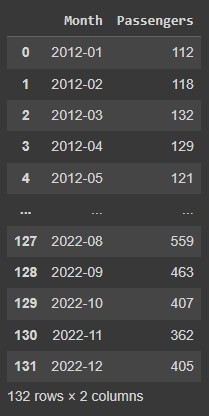
To get a better understanding of the time series components within our dummy data, we will run a quick decomposing. For that, we import the method from statsmodels library and run the decomposing on our dataset. We decided on an additive model and indicated, that one period contains 12 elements (months) in our data. A daily dataset would be period=365.
from statsmodels.tsa.seasonal import seasonal_decompose
decompose = seasonal_decompose(df_data_train.Passengers, model='additive', extrapolate_trend='freq', period=12)
decompose.plot().show()
This short piece of code will give us a visual impression of time series itself, but especially about the trend, the seasonality, and the residuals over time:
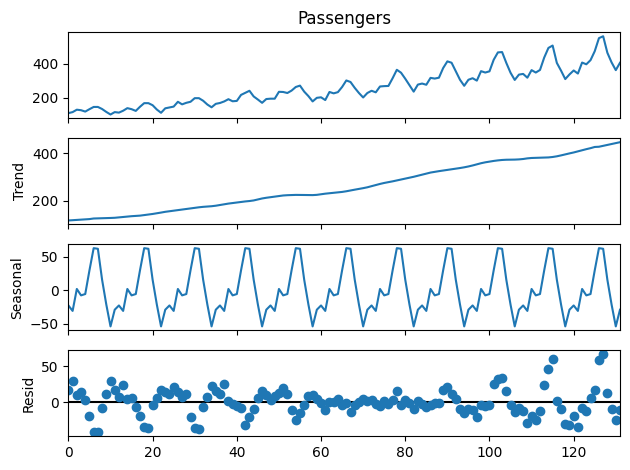
We can now clearly see both, a significantly increasing trend over the past 10 years as well as a recognizable seasonality pattern every year. Following those indications, we would now expect the model to predict some further increasing amount of passengers, following the seasonality peaks in the summer of the future year. But let’s try it out — time to apply some machine learning!
To fit models in Prophet, it is important to have at least a ‘ds’ (datestamp) and ‘y’ (value to be forecasted) column. We should make sure that our columns are renamed the reflect the same.
df_train_prophet = df_data_train
# date variable needs to be named "ds" for prophet
df_train_prophet = df_train_prophet.rename(columns={"Month": "ds"})
# target variable needs to be named "y" for prophet
df_train_prophet = df_train_prophet.rename(columns={"Passengers": "y"})
Now the magic can begin. The process to fit the model is fairly straightforward. However, please have a look at the documentation to get an idea of the large amount of options and parameters we could adjust in this step. To keep things simple, we will fit a simple model without any further adjustments for now — but please keep in mind that real-world data is never perfect: you will definitely need parameter tuning in the future.
model_prophet = Prophet()
model_prophet.fit(df_train_prophet)
That’s all we have to do to fit the model. Let’s make some predictions!
We have to make predictions on a table that has a ‘ds’ column with the dates you want predictions for. To set up this table, use the make_future_dataframe method, and it will automatically include historical dates. This way, you can see how well the model fits the past data and predicts the future. Since we handle monthly data, we will indicate the frequency with “freq=12″ and ask for a future horizon of 12 months (“periods=12”).
df_future = model_prophet.make_future_dataframe(periods=12, freq='MS')
display(df_future)
This new dataset then contains both, the training period as well as the additional 12 months we want to predict:
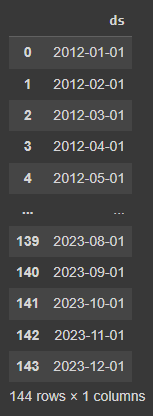
To make predictions, we simply call the predict method from Prophet and provide the future dataset. The prediction output will contain a large dataset with many different columns, but we will focus only on the predicted value yhat as well as the uncertainty intervals yhat_lower and yhat_upper.
forecast_prophet = model_prophet.predict(df_future)
forecast_prophet[['ds', 'yhat', 'yhat_lower', 'yhat_upper']].round().tail()
The table below gives us some idea about how the output is generated and stored. For August 2023, the model predicts a passenger amount of 532 people. The uncertainty interval (which is set by default to 80%) tells us in simple terms that we can expect most likely a passenger amount between 508 and 556 people in that month.
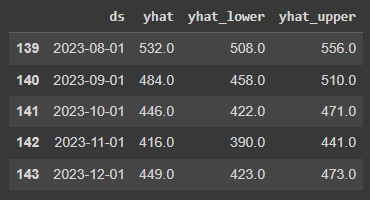
Finally, we want to visualize the output to better understand the predictions and the intervals.
To plot the results, we can make use of Prophet’s built-in plotting tools. With the plot method, we can display the original time series data alongside the forecasted values.
import matplotlib.pyplot as plt
# plot the time series
forecast_plot = model_prophet.plot(forecast_prophet)
# add a vertical line at the end of the training period
axes = forecast_plot.gca()
last_training_date = forecast_prophet['ds'].iloc[-12]
axes.axvline(x=last_training_date, color='red', linestyle='--', label='Training End')
# plot true test data for the period after the red line
df_data_test['Month'] = pd.to_datetime(df_data_test['Month'])
plt.plot(df_data_test['Month'], df_data_test['Passengers'],'ro', markersize=3, label='True Test Data')
# show the legend to distinguish between the lines
plt.legend()
Besides the general time series plot, we also added a dotted line to indicate the end of the training period and hence the start of the prediction period. Further, we made use of the true test dataset that we had prepared in the beginning.
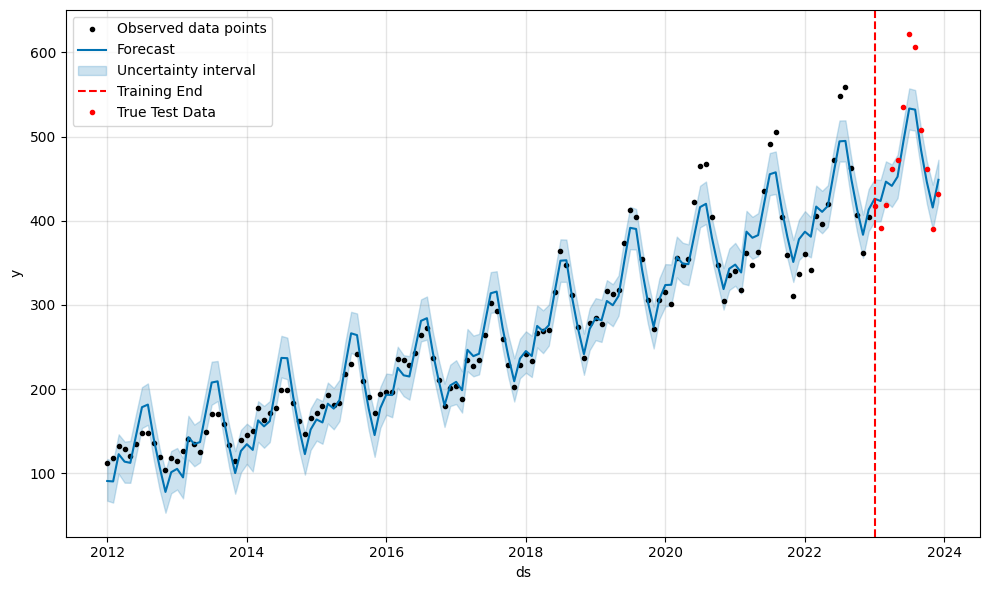
It can be seen that our model isn’t too bad. Most of the true passenger values are actually within the predicted uncertainty intervals. However, the summer months seem to be too pessimistic still, which is a pattern we can see in previous years already. This is a good moment to start exploring the parameters and features we could use with Prophet.
In our example, the seasonality is not a constant additive factor but it grows with the trend over time. Hence, we might consider changing the seasonality_mode from “additive” to “multiplicative” during the model fit. [4]
Our tutorial will conclude here to give some time to explore the large number of possibilities that Prophet offers to us. To review the full code together, I consolidated the snippets in this Python file. Additionally, you could upload this notebook directly to Colab and run it yourself. Let me know how it worked out for you!
Prophet is a powerful tool for predicting future values in time series data, especially when your data has repeating patterns like monthly or yearly cycles. It’s user-friendly and can quickly provide accurate predictions for your specific data. However, it’s essential to be aware of its limitations. If your data doesn’t have a clear pattern or if there are significant changes that the model hasn’t seen before, Prophet may not perform optimally. Understanding these limitations is crucial for using the tool wisely.
The good news is that experimenting with Prophet on your datasets is highly recommended! Every dataset is unique, and tweaking settings and trying different approaches can help you discover what works best for your specific situation. So, dive in, explore, and see how Prophet can enhance your time series forecasting.
I hope you find it useful. Let me know your thoughts! And feel free to connect on LinkedIn https://www.linkedin.com/in/jonas-dieckmann/ and/or to follow me here on medium.
[1] Shumway, Robert H.; Stoffer, David S. (2017): Time Series Analysis and Its Applications. Cham: Springer International Publishing.
[2] Brownlee, Jason (2017): Introduction to Time Series Forecasting With Python
[3] Rafferty, Greg (2021): Forecasting Time Series Data with Facebook Prophet
[4] https://facebook.github.io/prophet/docs/quick_start.html
Getting started predicting time series data with Facebook Prophet was originally published in Towards Data Science on Medium, where people are continuing the conversation by highlighting and responding to this story.
Originally appeared here:
Getting started predicting time series data with Facebook Prophet
Go Here to Read this Fast! Getting started predicting time series data with Facebook Prophet


Part 3 — a simple extension to zero-shot classification with Tip-Adapter.
Originally appeared here:
Improving CLIP performance in training-free manner with few-shot examples
Go Here to Read this Fast! Improving CLIP performance in training-free manner with few-shot examples



If you’ve clicked on this article, you’ve likely heard about Adam, a name that has gained notable recognition in many winning Kaggle competitions. It’s common to experiment with a few optimizers like SGD, Adagrad, Adam, or AdamW, but truly understanding their mechanics is a different story. By the end of this post, you’ll be among the select few who not only know about Adam optimization but also understand how to leverage its power effectively.
By the way, in my previous post I described the math behind Stochastic Gradient Descent, if you missed it, I recommend reading it.
Stochastic Gradient Descent: Math and Python Code
Index
· 1: Understanding the Basics
∘ 1.1: What is the Adam Optimizer?
∘ 1.2: The Mechanics of Adam
· 2. Adam’s Algorithm Explained
∘ 2.1 The Mathematics Behind Adam
∘ 2.2 The Role of Adaptive Learning Rates
· 3. Adam in Practice
∘ 3.1 Recreating the Algorithm from Scratch in Python
∘ 3.2 Adam in TensorFlow
· 4. Advantages and Challenges
∘ 4.1 Why Opt for Adam?
∘ 4.2 Addressing Adam’s Limitations

In machine learning, Adam (Adaptive Moment Estimation) stands out as a highly efficient optimization algorithm. It’s designed to adjust the learning rates of each parameter.
Imagine you’re navigating a complex terrain, like the one in the image above. In some areas, you need to take large strides, while in others, cautious steps are required. Adam optimization works similarly, it dynamically adjusts its step size, making it larger in simpler regions and smaller in more complex ones, ensuring a more effective and quicker path to the lowest point, which represents the least loss in machine learning.
Adam tweaks the gradient descent method by considering the moving average of the first and second-order moments of the gradient. This allows it to adapt the learning rates for each parameter intelligently.
At its core, Adam is designed to adapt to the characteristics of the data. It does this by maintaining individual learning rates for each parameter in your model. These rates are adjusted as the training progresses, based on the data it encounters.
Think of it as if you’re driving a car over different terrains. In some places, you accelerate (when the path is clear and straight), and in others, you decelerate (when the path gets twisty or rough). Adam modifies its speed (the learning rate_ based on the road (the gradient’s nature) ahead.
Indeed, the algorithm can remember the previous actions (gradients), and the new actions are guided by the previous ones. Therefore, Adams keeps track of the gradients from previous steps, allowing it to make informed adjustments to the parameters. This memory isn’t just a simple average; it’s a sophisticated combination of recent and past gradient information, giving more weight to the recent.
Moreover, in areas where the gradient (the slope of the loss function) changes rapidly or unpredictably, Adam takes smaller, more cautious steps. This helps avoid overshooting the minimum. Instead, in areas where the gradient changes slowly or predictably, it takes larger steps. This adaptability is key to Adam’s efficiency, as it navigates the loss landscape more intelligently than algorithms with a fixed step size.
This adaptability makes Adam particularly useful in scenarios where the data or the function being optimized is complex or has noisy gradients.
As you may have understood, the core of Adam’s algorithm lies in its computation of adaptive learning rates for each parameter.
1. Initialization
In the beginning, Adam initializes two vectors, m, and v, which are both of the same shape as the parameters θ of the model. The vector m is intended to store the moving average of the gradients, while v keeps track of the moving average of the squared gradients. These moving averages are key to Adam’s adaptive adjustments. A time step counter t is also initialized to zero. It keeps track of the number of iterations (or updates) that the algorithm has completed.
The initial values are typically set as follows:
2. Compute Gradients
For each iteration t, Adam computes the gradient gt. This gradient is the derivative of the objective function (which we are trying to minimize) concerning the current model parameters θt.
Therefore, it represents the direction in which the function increases most rapidly.
Mathematically:

Where:
3. Update m (first moment estimate)
Then, we update the first-moment vector m, which stores the moving average of the gradients.
This update is a combination of the previous value of m and the new gradient, weighted by parameters β1 and 1−β1, respectively.
This process can be likened to having a short-term memory of past gradients, emphasizing more recent observations. It provides a smoothed estimate of the gradient direction.
Mathematically:

Where:
4. Update v (second raw moment estimate)
Similarly, the second-moment vector v is updated. This vector gives an estimate of the variance (or unpredictability) of the gradients, therefore it stores the squared gradients that are accumulated.
Like the first moment, this is also a weighted combination, but of the past squared gradients and the current squared gradient.
Mathematically:

Where:
5. Correct the bias in the moments
Since m and v are initialized to 0, they are biased toward 0, which leads to a bias towards zero, especially during the initial time steps, particularly during the initial steps. Adam overcomes this bias by correcting the vector by the decay rate, which is b1 for m (first-moment decay rate), and b2 for v (second-moment decay rate).
This correction is important as it ensures that the moving averages are more representative, particularly in the early stages of training.
Mathematically:

Where:

Where:
6. Update the parameters
The final step is the update of the model parameters. This step is where the actual optimization takes place, moving the parameters in the direction that minimizes the loss function. The update utilizes the adaptive learning rates calculated in the previous steps.
Mathematically:

Where:
The key feature of Adam is its adaptive learning rates. Unlike traditional gradient descent, where a single learning rate is applied to all parameters, Adam adjusts the rate based on how frequently a parameter is updated.
Like in other optimization algorithms, the learning rate is a critical factor in how significantly the model parameters are adjusted. A higher learning rate could lead to faster convergence but risks overshooting the minimum, while a lower learning rate ensures more stable convergence but at the risk of getting stuck in local minima or taking too long to converge.
The unique aspect of Adam is that the update to each parameter is scaled individually. The amount by which each parameter is adjusted is influenced by both the first moment (capturing the momentum of the gradients) and the second moment (reflecting the variability of the gradients). This adaptive adjustment leads to more efficient and effective optimization, especially in complex models with many parameters.
The small constant ϵ is added to prevent any issues with division by zero, which is especially important when the second moment estimate v^t is very small. This addition is a standard practice in numerical algorithms to ensure stability.
Now let’s move to the Python code, which really can make us understand how the algorithm works. In this example, I am recreating a simplified version of Adam, applied to Linear Regression. While, Adam is more commonly seen in the deep learning domain, building from scratch a Neural Network would require another post itself (follow me to stay updated, it’s coming…).
However, consider that you could replace the Linear Regression with other algorithms, as long as you adapt the code for it.
Let’s get started with creating the AdamOptimizer class first:
# Adam Optimizer (use the class from the previous response)
class AdamOptimizer:
def __init__(self, learning_rate=0.001, beta1=0.9, beta2=0.999, epsilon=1e-8):
"""
Constructor for the AdamOptimizer class.
Parameters
----------
learning_rate : float
Learning rate for the optimizer.
beta1 : float
Exponential decay rate for the first moment estimates.
beta2 : float
Exponential decay rate for the second moment estimates.
epsilon : float
Small value to prevent division by zero.
Returns
-------
None.
"""
self.learning_rate = learning_rate
self.beta1 = beta1
self.beta2 = beta2
self.epsilon = epsilon
self.m = None
self.v = None
self.t = 0
def initialize_moments(self, params):
"""
Initializes the first and second moment estimates.
Parameters
----------
params : dict
Dictionary containing the model parameters.
Returns
-------
None.
"""
self.m = {k: np.zeros_like(v) for k, v in params.items()}
self.v = {k: np.zeros_like(v) for k, v in params.items()}
def update_params(self, params, grads):
"""
Updates the model parameters using the Adam optimizer.
Parameters
----------
params : dict
Dictionary containing the model parameters.
grads : dict
Dictionary containing the gradients for each parameter.
Returns
-------
updated_params : dict
Dictionary containing the updated model parameters.
"""
if self.m is None or self.v is None:
self.initialize_moments(params)
self.t += 1
updated_params = {}
for key in params.keys():
self.m[key] = self.beta1 * self.m[key] + (1 - self.beta1) * grads[key]
self.v[key] = self.beta2 * self.v[key] + (1 - self.beta2) * np.square(grads[key])
m_corrected = self.m[key] / (1 - self.beta1 ** self.t)
v_corrected = self.v[key] / (1 - self.beta2 ** self.t)
updated_params[key] = params[key] - self.learning_rate * m_corrected / (np.sqrt(v_corrected) + self.epsilon)
return updated_params
The code can be broken down into three parts:
Initialization of the class
def __init__(self, learning_rate=0.001, beta1=0.9, beta2=0.999, epsilon=1e-8):
self.learning_rate = learning_rate
self.beta1 = beta1
self.beta2 = beta2
self.epsilon = epsilon
self.m = None
self.v = None
self.t = 0
Here, the class requests as inputs the learning rate, beta 1 (first-moment decay rate), beta 2 (second-moment decay rate), and epsilon.
Moreover, it temporarily sets the constants m, and v to None.
Initialization of the moment vectors
def initialize_moments(self, params):
self.m = {k: np.zeros_like(v) for k, v in params.items()}
self.v = {k: np.zeros_like(v) for k, v in params.items()}
In this step, we request an input “params”, a dictionary storing the model parameters. In the linear regression case, the model parameters are weight and bias, therefore we will expect two keys.
Then, we initialize two dictionaries: m, the first-moment vector, which will store the moving average of the gradients, and v, the second-moment vector, which will store the variance of the gradients.
Both of them will have several keys equal to the number of keys in the params dictionary (in our case two), and each key will have a value array with the same length as the values in the original key in params. In this case, the value array will store only 0 values, as we are initializing it.
Update the params dictionary
def update_params(self, params, grads):
if self.m is None or self.v is None:
self.initialize_moments(params)
self.t += 1
updated_params = {}
for key in params.keys():
self.m[key] = self.beta1 * self.m[key] + (1 - self.beta1) * grads[key]
self.v[key] = self.beta2 * self.v[key] + (1 - self.beta2) * np.square(grads[key])
m_corrected = self.m[key] / (1 - self.beta1 ** self.t)
v_corrected = self.v[key] / (1 - self.beta2 ** self.t)
updated_params[key] = params[key] - self.learning_rate * m_corrected / (np.sqrt(v_corrected) + self.epsilon)
return updated_params
The last step is the core of the AdamOptimizer class, it will first start by initializing the first and second-moment vectors if they are not initialized.
Then, we update self.t, which is the time counter, which was originally set to 0, when we initialized the class. We, then create an empty updated_params dictionary, that will store the new model parameters after Adam optimization.
Lastly, we run the Adam optimization algorithm on the existing parameters, by iterating over every parameter with a for a loop. Since this is the main aspect of our operation let’s break it down:
self.m[key] = self.beta1 * self.m[key] + (1 - self.beta1) * grads[key]
self.v[key] = self.beta2 * self.v[key] + (1 - self.beta2) * np.square(grads[key])
These two lines of code update the first and second-moment vectors, using the formulas defined in subsection 2.1.
m_corrected = self.m[key] / (1 - self.beta1 ** self.t)
v_corrected = self.v[key] / (1 - self.beta2 ** self.t)
Here, we are updating the value in the two vectors by correcting them for the bias.
updated_params[key] = params[key] - self.learning_rate * m_corrected / (np.sqrt(v_corrected) + self.epsilon)
Lastly, we compute Adam optimization and store the new value in the updated_params dictionary.
Now, while this is technically the whole code we need for the Adam optimizer, this would be quite useless if we don’t have anything to optimize. Therefore, we will create a Linear Regression class to feed something to Adam.
# Linear Regression Model
class LinearRegression:
def __init__(self, n_features):
"""
Constructor for the LinearRegression class.
Parameters
----------
n_features : int
Number of features in the input data.
Returns
-------
None.
"""
self.weights = np.random.randn(n_features)
self.bias = np.random.randn()
def predict(self, X):
"""
Predicts the target variable given the input data.
Parameters
----------
X : numpy array
Input data.
Returns
-------
numpy array
Predictions.
"""
return np.dot(X, self.weights) + self.bias
This code is pretty self-explanatory. However, suppose you want to know more about Linear Regression and call yourself a Linear Regression master. In that case, I highly recommend you to read my article about it, where I recreate a more complex version of the one defined above.
Demystifying Linear Regression
Lastly, we define a wrapper class, which will combine both the Adam Optimizer class and the Linear Regression class:
class ModelTrainer:
def __init__(self, model, optimizer, n_epochs):
"""
Constructor for the ModelTrainer class.
Parameters
----------
model : object
Model to be trained.
optimizer : object
Optimizer to be used for training.
n_epochs : int
Number of training epochs.
Returns
-------
None.
"""
self.model = model
self.optimizer = optimizer
self.n_epochs = n_epochs
def compute_gradients(self, X, y):
"""
Computes the gradients of the mean squared error loss function
with respect to the model parameters.
Parameters
----------
X : numpy array
Input data.
y : numpy array
Target variable.
Returns
-------
dict
Dictionary containing the gradients for each parameter.
"""
predictions = self.model.predict(X)
errors = predictions - y
dW = 2 * np.dot(X.T, errors) / len(y)
db = 2 * np.mean(errors)
return {'weights': dW, 'bias': db}
def train(self, X, y, verbose=False):
"""
Runs the training loop, updating the model parameters and optionally printing the loss.
Parameters
----------
X : numpy array
Input data.
y : numpy array
Target variable.
Returns
-------
None.
"""
for epoch in range(self.n_epochs):
grads = self.compute_gradients(X, y)
params = {'weights': self.model.weights, 'bias': self.model.bias}
updated_params = self.optimizer.update_params(params, grads)
self.model.weights = updated_params['weights']
self.model.bias = updated_params['bias']
# Optionally, print loss here to observe training
loss = np.mean((self.model.predict(X) - y) ** 2)
if epoch % 1000 == 0 and verbose:
print(f"Epoch {epoch}, Loss: {loss}")
The main goal of the class is to iterate for several iterations given by the variable n_epochs optimizing the parameters of the linear regression by the Adam optimizer.
Compute the gradients
def compute_gradients(self, X, y):
predictions = self.model.predict(X)
errors = predictions - y
dW = 2 * np.dot(X.T, errors) / len(y)
db = 2 * np.mean(errors)
return {'weights': dW, 'bias': db}
In this class, we finally compute the gradients. Indeed, in Subsection 2.1 that was the second step. Here it was not possible to calculate the gradients until we defined a model. Therefore, this function will vary based on the model you will feed to Adam. Since we are using Linear regression we only need to calculate the gradient of the weights and the bias.
Train
def train(self, X, y, verbose=False):
for epoch in range(self.n_epochs):
grads = self.compute_gradients(X, y)
params = {'weights': self.model.weights, 'bias': self.model.bias}
updated_params = self.optimizer.update_params(params, grads)
self.model.weights = updated_params['weights']
self.model.bias = updated_params['bias']
loss = np.mean((self.model.predict(X) - y) ** 2)
if epoch % 1000 == 0 and verbose:
print(f"Epoch {epoch}, Loss: {loss}")
Finally, we create the train method. As we mentioned before, this class iterates n_epochs times. In each iteration, it computes the gradients of weights and bias resulting from Linear Regression, then feeds the gradients to the Adam optimizers, and sets the resulting weights and bias back to the model.
You can access the complete code with its implementation in a Jupyter Notebook here:
models-from-scratch-python/XGBoost/demo.ipynb at main · cristianleoo/models-from-scratch-python
At this point, you will have a good understanding of the Adam optimizer. Now that you know how it works, you actually can discard the code above as you’ll likely use a more efficient implementation from Tensorflow or PyTorch with just a few lines of code.
In this case, we will use TensorFlow, and we will create a simple neural network with two layers and 64 nodes. Then, we will “compile” the model with Adam optimization. While compiling the optimizer is adjusting the weights of the network to minimize the loss.
import tensorflow as tf
import numpy as np
# Generate Sample Data
# For demonstration, we create synthetic data for a regression task
X = np.random.rand(100, 3) # 100 samples, 3 features
y = X @ np.array([2.0, -1.0, 3.0]) + 1.5 # Linear relationship with some coefficients and bias
# Create the Neural Network
model = tf.keras.Sequential([
tf.keras.layers.Dense(64, activation='relu', input_shape=(3,)), # Input layer with 3 inputs
tf.keras.layers.Dense(64, activation='relu'), # Another dense layer
tf.keras.layers.Dense(1) # Output layer with 1 unit (for regression)
])
# Compile the Model with the Adam Optimizer
model.compile(optimizer=tf.keras.optimizers.Adam(learning_rate=0.001),
loss='mean_squared_error') # MSE is typical for regression
# Train the Model
model.fit(X, y, epochs=10) # Train for 10 epochs as an example
At this point, you know how the algorithm works, but you may still wondering when is Adam a good choice.
1. Dealing with Sparse Data
Adam is particularly effective when working with data that leads to sparse gradients. This situation is common in models with large embedding layers or when dealing with text data in natural language processing tasks.
2. Training Large-Scale Models
Adam is well-suited for training models with a large number of parameters, such as deep neural networks. Its adaptive learning rate helps navigate the complex optimization landscapes of such models efficiently. However, this is not always the case, as we can see when we applied Adam to Linear Regression.
3. Achieving Rapid Convergence
When we don’t have much time for the convergence to happen, Adam comes to help. This is thanks to its adaptive learning, which guarantees a faster convergence compared to its rival SGD.
4. For Online and Batch Training
It’s versatile enough to be used in both online learning scenarios (where the model is updated continuously as new data arrives) and batch learning.
While the Adam optimizer is versatile and effective in many scenarios, there are certain challenges and considerations to keep in mind.
1. Tuning Hyperparameters
While Adam is less sensitive to learning rate changes compared to other optimizers, choosing an appropriate initial learning rate is still crucial. A too-high learning rate may lead to instability, while too low a rate can slow down the training process.
The default values of β1 and β2 (typically 0.9 and 0.999, respectively) work well in most cases, but in some scenarios, adjusting them can yield better results.
2. Handling Noisy Data and Outliers
While Adam is generally robust to noisy data, extreme outliers or highly noisy datasets might impact its performance. Preprocessing data to remove or diminish the impact of outliers can be beneficial.
3. Choice of Loss Function
The efficiency of Adam can vary with different loss functions. Make sure that the loss function resonates with the problem you are solving, and experiment with a few of them to see which one works best.
4. Computational Considerations
Adam typically requires more memory than simple gradient descent algorithms because it maintains moving averages for each parameter. This should be considered when working with very large models or limited computational resources.
To effectively leverage Adam, it’s essential to understand both its strengths and limitations. Fine-tuning its parameters and being mindful of the nature of your data and problem can help in harnessing its full potential. Regular monitoring and validation are key to ensuring that the optimizer is performing optimally. Keep in mind these challenges, follow the best practices recommended in this article and you are ready to experiment with Adam.
If you liked this article consider leaving a like, and follow me to be updated on my latest posts. My goal is to recreate all the most popular algorithms from scratch and make machine learning accessible to everyone.
The Math behind Adam Optimizer was originally published in Towards Data Science on Medium, where people are continuing the conversation by highlighting and responding to this story.
Originally appeared here:
The Math behind Adam Optimizer


This story continues at The Next Web
Go Here to Read this Fast! Europe outpacing US on quantum investment, report finds
Originally appeared here:
Europe outpacing US on quantum investment, report finds



The AppleInsider team searches the internet for amazing deals at online retailers to develop a list of deep discounts on popular tech gadgets, including deals on AirPods, TVs, accessories, and other products. We share the most valuable deals daily to help you get more bang for your buck.
Originally appeared here:
Daily deals Jan. 30: AirPods Pro $155, $300 off MacBook Air, Apple accessories from $9.99, more



Developers taking part in the beta program can acquire the latest builds through the Apple Developer Center or by updating their iPhone via the Settings app. Public beta versions typically appear shortly after the developer versions, and public participants can sign up through the Apple Beta Software Program website.
Go Here to Read this Fast! iOS 17.4 beta 1 gets rare mid-stream update
Originally appeared here:
iOS 17.4 beta 1 gets rare mid-stream update



In partnership with Goldman Sachs, Apple launched the Apple Card in 2019. Since then, it’s been a notable, if not somewhat controversial, hit.
In 2023 alone, users earned over $1 billion in Daily Cash from using Apple Card. Cardholders also took advantage of the new savings account feature that was launched in April 2023. According to Apple, users reached over $10 billion in deposits “in just a few short months.”